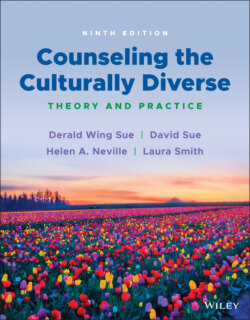Читать книгу Counseling the Culturally Diverse - Laura Smith L. - Страница 12
PEDAGOGICAL STRENGTHS
ОглавлениеOne of the main goals of the eighth edition has been to better engage students in the material and allow them to become active participants in digesting multicultural counseling concepts. We have increased our focus on pedagogy by providing instructors with exercises and activities to facilitate experiential learning for students. We open every chapter with broad chapter objectives, followed by more specific—and oftentimes controversial—reflection and discussion questions interspersed throughout, which allow for more concentrated and detailed discussion by students on identifiable topical areas.
Further, every chapter opens with a clinical vignette, longer narrative, or situational example that previews the major concepts and issues discussed within. Many of these are new and serve to anchor the multicultural chapter focus questions issues to follow. They add life and meaning to the chapter concepts and research. They serve as prompts to address the opening “course objectives,” but instructors and trainers can also use them as discussion questions throughout the course or workshop. To further stimulate interest and meaning to multicultural counseling concepts, we sprinkle at least two new features throughout the chapters: (a) Did You Know? and (b) By the Numbers. These new features provide brief facts and findings of interest that provoke thought and provide interesting insights. As in the previous edition, we have retained the “Implications for Clinical Practice” and “Summary” sections at the end of every chapter.
There are many other major resources available for instructor use. These are accessible to all instructors through the Wiley site. The use of videos and case studies are compatible with the topical issues in CCD.
1 Multicultural Video Series. A series of brief simulated multicultural counseling videos that can be used in the classroom or viewed online. Each video relates to issues presented in one of the first 11 chapters. They are excellent training aids that allow students to witness multicultural blunders by counselors, identify cultural and sociopolitical themes in the counseling process, discuss and analyze what can go wrong in a session, and suggest culturally appropriate intervention strategies. Following each video, Drs. Joel M. Fillmore and Derald Wing Sue discuss and analyze each session in the context of the themes of the chapter. Instructors have many ways to use the videos to stimulate classroom discussion and understanding.
2 Multicultural Counseling Casebook. In keeping with the importance of applying research and theory to work with culturally diverse populations, and client and client systems, we have accumulated a number of outstanding cases that will stimulate classroom discussion of issues related to race, culture, ethnicity, marginality and clinical work. These case vignettes, when used as a teaching/training tool by knowledgeable instructors can:Help students become culturally aware of their own values, biases, and assumptions about human behavior,Expand their awareness of other worldviews,Anticipate possible cultural barriers in counseling and therapy,Generate alternative counselor intervention strategies more consistent with the life experiences of marginalized populations.
3 Separate Case Study Book. For instructors who wish to present more in depth clinical cases that go beyond clients of color, we encourage them to use Sue, D. W., Gallardo, M., & Neville, H. (2014). Case studies in multicultural counseling and therapy. Hoboken, NJ: Wiley.
4 Multicultural Resources for Student Evaluation and Activities. On the Wiley website for CCD are the traditional tools for testing and facilitating student learning (test bank of multiple choice questions, true‐false items, essays, power point slides for classroom lectures/discussions, etc.) for each major chapter. With respect to the test items, questions are rated as to their difficulty. This allows instructors to balance the difficulty level of exams for their students.
